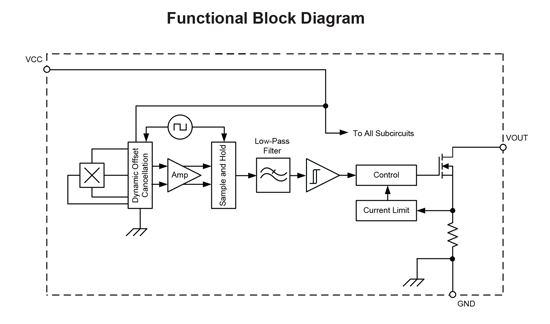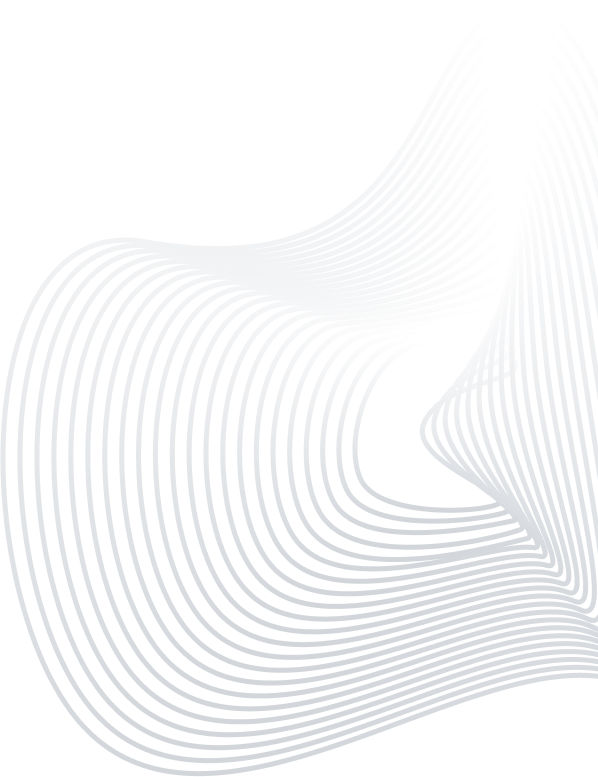ホール効果センサー技術

The Hall effect is named after Edwin Hall, who in 1879 discovered that a voltage potential develops across a current-carrying conductive plate when a magnetic field passes through the plate in a direction perpendicular to the plane of the plate.
The fundamental physical principle behind the Hall effect is the Lorentz force. When an electron moves along a direction, v, perpendicular to the applied magnetic field, B, it experiences a force, F, normal to both the applied field and the current flow. In response to this force, the electrons move in a curved path along the conductor (Hall element). Because of this, a net charge, and therefore, a voltage, develops across the plate. By this property, the Hall effect is employed as a magnetic sensor.
Allegro Hall-effect sensor integrated circuits (ICs) incorporate a Hall element with other circuitry, such as op-amps and comparators, to make digital position sensors and speed sensors, as well as linear and angle sensors with analog outputs.

In many cases, Allegro magnetic sensor ICs also incorporate proprietary packaging that includes a “back-bias” magnet to enable the sensor to sense the location of a ferrous (magnetic) target rather than an external magnetic field. The target, e.g., a steel gear, modifies the magnetic field from the integrated magnet. Differential sensing and advanced algorithms are used to optimize performance and compensate for dynamic or sudden air gap changes, vibration, and mechanical tolerances.
Hall-effect sensors also lend themselves to non-contact current sensing, as the current in a conductor creates a magnetic field that is proportional to the magnitude of the current. Unique packaging creates galvanically isolated, small footprint current sensing ICs with very low insertion losses.
Since their inception, Allegro has pioneered several major advances in the field of Hall-effect sensor ICs including chopper stabilization, vertical Hall-effect technology, circular vertical Hall (CVH) arrays, and non-intrusive high-speed hardware diagnostics. Visit each section below to learn more.
Chopper Stabilization
The signals produced by the Hall effect within an integrated circuit are tiny—possibly only microvolts of signal. This signal can easily be corrupted by noise or offsets such as those induced by temperature changes or mechanical stress. State-of-the-art sensors employ chopper stabilization to cancel out these effects.
Learn more »
Multi-Dimensional Sensing
Traditional Hall-effect sensors are only sensitive to magnetic fields perpendicular to the plane of the die. Sophisticated design and fabrication techniques have made it possible to create vertical Hall elements that allow a sensor to determine field direction as well as magnitude. This can be leveraged to build more sensitive switches, better rotary position sensors, and angle sensors.
Learn more »
Diagnostics for Built-In Self-Test (BIST)
Hall-effect sensors are often used in safety-critical applications, including automobiles. The development of fast, non-intrusive self-diagnostics (BIST) has enabled sensors to meet the most stringent safety standards including ISO 26262:2011.
Learn more »

ホール効果センサー技術
ホール効果は、Edwin Hall にちなんで名づけられました。彼は 1879 年に、磁場がプレートの平面に対して垂直な方向にプレートを通過するときに、電流が流れる導電プレート全体に電位が発生することを発見しました。
ホール効果の背後にある基本的な物理原則はローレンツ力です。 電子が印加磁場 B に垂直な方向 v に沿って移動すると、印加磁場と電流の流れの両方に対して垂直な力 F が発生します。 この力に反応して、電子は導体 (ホール素子) に沿って曲線の経路で移動します。 このため、正味の電荷、つまり電圧がプレート全体で発生します。 この特性により、ホール効果は磁気センサーとして利用されています。
Allegro のホール効果センサーの集積回路 (IC) は、オペアンプやコンパレーターなど、他の回路とホール素子を組み込んで、 デジタルのポジション センサーと速度センサー、およびアナログ出力を備えたリニア センサーと角度センサーを構築します。
多くの場合、Allegro の磁気センサー IC には「逆バイアス」マグネットを含む独自のパッケージングも組み込まれているので、センサーが、外部磁場ではなく鉄製 (磁気) ターゲットの位置を検出できます。 ターゲット (たとえばスチール ギヤ) は、統合マグネットからの磁場を変化させます。 差動センサーと高度なアルゴリズムを使用して、性能を最適化し、動的または突然のエア ギャップ、振動、機械的公差を補正します。
ホール効果センサーは、導体内の電流が電流の大きさに比例する磁場を生成するため、非接触型電流センシングにも役立ちます。 独自のパッケージングにより、挿入損失が非常に少ない直流的に絶縁された小さなフットプリントの電流センサー IC を作成します。
Allegro は創業以来、チョッパー安定化、垂直ホール効果技術、円形垂直ホール (CVH) アレイ、非侵入型高速ハードウェア診断など、ホール効果センサー IC のいくつかの主要な先進分野でパイオニアとなりました。 詳細については、下の各セクションを参照してください。
チョッパー安定化
集積回路内のホール効果によって生成される信号は非常に小さく、わずかなマイクロボルトの信号のみになる可能性があります。 この信号は、温度変化や機械的ストレスによって引き起こされるようなノイズやオフセットによって簡単に壊れる可能性があります。 最先端のセンサーでは、チョッパー安定化を採用して、これらの影響を解消しています。
詳細をご覧ください »
多次元センサー
従来型のホール効果センサーは、ダイの平面に対して垂直な磁場のみを感知します。 精巧な設計と製造技術により、センサーが磁場の方向と大きさを判断できるようにする垂直ホール素子の作成が可能になりました。 これを活用して、感度の高いスイッチ、優れた回転ポジション センサー、および角度センサーを構築できます。
詳細をご覧ください »
組み込みセルフテスト (BIST) の診断
ホール効果センサーは、多くの場合、自動車をはじめとする安全性が重視される用途で使用されます。 非侵入型の高速な自己診断 (BIST) の開発により、センサーは ISO 26262:2011 を含む最も厳しい安全基準を満たすことができるようになりました。
詳細をご覧ください»
インサイトとイノベーション
Giant Magnetoresistance versus Hall-effect: A Comparison of Technologies for Speed Sensor Applications
